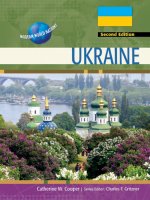- Trang chủ >>
- Khoa Học Tự Nhiên >>
- Vật lý
Modern world nations kuwait
Bạn đang xem bản rút gọn của tài liệu. Xem và tải ngay bản đầy đủ của tài liệu tại đây (11.74 MB, 121 trang )
CH.WN.Kuw.aFM.Final.q 4/26/02 1:58 PM Page 1
AFGHANISTAN
AUSTRIA
BAHRAIN
BERMUDA
CHINA
CUBA
EGYPT
ETHIOPIA
REPUBLIC OF GEORGIA
GERMANY
KUWAIT
IRAN
IRAQ
ISRAEL
MEXICO
NEW ZEALAND
PAKISTAN
RUSSIA
SAUDI ARABIA
SCOTLAND
SOUTH KOREA
UKRAINE
CH.WN.Kuw.aFM.Final.q 4/26/02 1:58 PM Page 2
CH.WN.Kuw.aFM.Final.q 4/26/02 1:58 PM Page 3
Kuwait
Dr. Solomon A. Isiorho
Indiana-Purdue University, Fort Wayne
Series Consulting Editor
Charles F. Gritzner
South Dakota State University
Chelsea House Publishers
Philadelphia
Frontispiece: Flag of Kuwait
Cover: Kuwait City at nightfall.
CHELSEA HOUSE PUBLISHERS
EDITOR IN CHIEF Sally Cheney
DIRECTOR OF PRODUCTION Kim Shinners
CREATIVE MANAGER Takeshi Takahashi
MANUFACTURING MANAGER Diann Grasse
Staff for KUWAIT
EDITOR Lee Marcott
PRODUCTION ASSISTANT Jaimie Winkler
PICTURE RESEARCHER 21st Century Publishing and Communications, Inc.
COVER AND SERIES DESIGNER Takeshi Takahashi
LAYOUT 21st Century Publishing and Communications, Inc.
©2002 by Chelsea House Publishers, a subsidiary of Haights Cross Communications.
All rights reserved. Printed and bound in the United States of America.
3 5 7 9 8 6 4 2
Library of Congress Cataloging-in-Publication Data
Isiorho, S. A. (Solomon A.)
Kuwait / S.A. Isiorho.
p. cm. — (Modern world nations)
Includes bibliographical references and index.
ISBN 0-7910-7105-7 — ISBN 0-7910-6781-5 (HC)
1. Kuwait. I. Title. II. Series.
DS247.K8 I82 2002
953.67—dc21
2002004479
CH.WN.Kuw.aFM.Final.q 4/26/02 1:58 PM Page 5
Table of Contents
1 Introduction to Kuwait
9
2 The Natural Environment
15
3 A Proud Past
25
4 Islam in Kuwait
39
5 The People and Culture of Kuwait
51
6 Government
67
7 Economy
79
8 The Gulf War
89
9 Leisure Time in Kuwait
10 Kuwait Looks Ahead
Facts at a Glance
History at a Glance
Bibliography
Index
101
107
110
111
112
113
CH.WN.Kuw.aFM.Final.q 4/26/02 1:58 PM Page 6
CH.WN.Kuw.aFM.Final.q 4/26/02 1:58 PM Page 7
Kuwait
CH.WN.Kuw.C01.Final.q 4/26/02 1:57 PM Page 8
A Kuwaiti man and woman in traditional clothing walk by the coastline in Kuwait City.
CH.WN.Kuw.C01.Final.q 4/26/02 1:57 PM Page 9
1
Introduction
to Kuwait
“W
ar,” said American writer Ambrose Bierce, “is
God’s way of teaching Americans geography.”
Although written nearly a century ago, his
observation certainly holds true in regard to Kuwait. This
small, little known, Middle Eastern country suddenly was
thrust onto the global stage in August 1990, when it was
attacked and overrun by military forces from neighboring
Iraq. American and other military forces immediately intervened in defense of Kuwait in what came to be known as
the “Gulf War.” As a result of widespread media attention and
the active participation of thousands of American troops in
the conflict, Americans learned a great deal about Kuwait’s
geographic conditions.
Kuwait is located on the northeastern corner of the
9
CH.WN.Kuw.C01.Final.q 4/26/02 1:57 PM Page 10
10
Kuwait
Arabian Peninsula, bordering the northwestern edge of
the Persian Gulf (known locally as the Arabian Gulf ). It
is located between 28 and 30 degrees north latitude, a
position comparable to that of southern Texas and
northernmost Mexico—both of which, like Kuwait, are
also desert environments. Its shape resembles the head of
a short-beaked bird, with the beak pointing westward.
The country spans only about 100 miles (162 kilometers)
in an east-west direction, and 125 miles (200 kilometers)
north-to-south. Its 6,880 square mile (17,818 square
kilometer) area is sandwiched between two much larger
neighboring states.
To the south lie the parched landscapes of oil rich
Saudi Arabia; to the northwest lies Iraq, also rich in oil
reserves and the location of historic Mesopotamia—a
fertile, low-lying plain formed by the Tigris and
Euphrates Rivers that was the “Cradle of Western
Civilization.” Another Middle Eastern power, Iran, is
located about 25 miles from the tip of northeastern
Kuwait, across a small strip of Iraq that reaches the
Persian Gulf. Kuwait’s eastern boundary is 121 miles (195
kilometers) of coastline. In the north, the gulf is shallow
and muddy, because of silt deposited by the combined
Tigris and Euphrates Rivers. In the south, away from the
delta, the water is deeper and much cleaner, and the coast
has many fine sandy beaches.
Historically, the area that is now Kuwait was called
Qurain. This name comes from the Arabic words qarn
(a high hill) and kout (fortress). Thus, the country’s
name provides a strong clue to the importance of its
centuries-old role as a strategic location for trade, commerce,
and control of navigation in the northern Persian Gulf.
Although its history can be traced back thousands of
years, the modern country of Kuwait is relatively new.
It began in the mid-18th century with the arrival of
CH.WN.Kuw.C01.Final.q 4/26/02 1:57 PM Page 11
Introduction to Kuwait
members of the Utub clan from what is now Saudi Arabia.
This group has played an important role in Kuwait’s
recent history.
Kuwait’s present-day importance is far greater than its
size or population might suggest. With an area about the
same as New Jersey and a population of just over two
million (only one-quarter that of New Jersey), it might
seem that the country would hardly be a “blip” on the radar
screen of global importance. For two major reasons, however, Kuwait is a very important country—particularly to
the United States and other Western powers. First, it has a
strategic location. Kuwait lies between three much larger
and more powerful countries—Saudi Arabia, Iraq, and
Iran. Together, these four states possess an estimated 50
percent of Earth’s known petroleum reserves. But the
region is one of almost constant turbulence and—as was
proved during the Gulf War—conflict can seriously disrupt
the flow of vital energy resources to the United States and
other countries.
Kuwait’s position both on the Persian Gulf and near the
spot where its neighbors almost join make its location one
of the most important in the entire Middle East. A second
factor of extreme importance is that Kuwait, itself, has huge
energy deposits. It is a major producer of oil and natural gas
and is one of the largest suppliers of petroleum to the
United States.
When visiting Kuwait today, there are a surprising
number of things to see and experience. The country is
quite modern by Middle Eastern standards. Much of its
shiny new appearance is the result of rebuilding in the
aftermath of the Gulf War. Because of the country’s huge
oil production and relatively small population, statistically,
Kuwaitis enjoy one of the world’s highest per capita
incomes, and gross domestic products. The country also is
unique in that more than half of its population is made up
11
CH.WN.Kuw.C01.Final.q 4/26/02 1:58 PM Page 12
12
Kuwait
Kuwait is located on the northeastern corner of the Arabian Peninsula, bordering the
northwestern edge of the Persian Gulf. It is sandwiched in between Iraq and Saudi Arabia
and spans about 100 miles (162 kilometers) from east to west and about 125 miles (200
kilometers) from north to south.
CH.WN.Kuw.C01.Final.q 4/26/02 1:58 PM Page 13
Introduction to Kuwait
of non-Kuwaitis. By some estimates, nearly three of every
five people in Kuwait were born elsewhere. They flock to
the country to find high paying jobs in this relatively safe
and stable land.
13
CH.WN.Kuw.C02.Final.q 4/26/02 1:56 PM Page 14
This aerial view of a town in Kuwait shows the flat, desert land that is typical
of the country.
CH.WN.Kuw.C02.Final.q 4/26/02 1:56 PM Page 15
2
The Natural
Environment
K
uwait’s natural landscapes reflect its arid climate. Desert
features—landforms, vegetation, and the lack of
permanent freshwater lakes or streams—dominate the
region. Much of the country is relatively flat and featureless.
There are no mountains or high plateaus. In fact, the highest
elevation reaches only about 1,000 feet (306 meters) above sea
level. There are less than eight square miles of farmland in the
entire country, and there are no surface water features to be
found anywhere. Only along the coast does the environment
show much change. Here, the gulf waters appear as a gigantic
oasis—but the water is salty, and therefore is not suitable for
drinking or irrigation without being desalinized (the removal
of salt) by a costly process.
15
CH.WN.Kuw.C02.Final.q 4/26/02 1:56 PM Page 16
16
Kuwait
Islands
Kuwait has nine islands, of which Bubyan is the largest. It
occupies an area of about 330 square miles (860 square kilometers). The island lies just off the Shatt al-Arab Delta and, in
fact, was formed primarily by sediments deposited by this
stream that carries the combined flow of the Tigris and
Euphrates. There is very little vegetation. Small sand dunes
near the shore rise above the island’s otherwise flat surface. No
people currently live on Bubyan. Warbah Island marks the
northernmost part of Kuwait. This low island can become
submerged during high tides, and like Bubyan Island it is not
inhabited. Failaka, located about 12 miles (20 kilometers) east
of Kuwait City, is the most scenic and famous of the country’s
islands. It was first settled as early as 10,000 years ago, and by
3000 B.C.E. (Before the Common Era), it was inhabited by
people of the Dilmun civilization that brought both wealth and
widespread recognition to the region. During the 4th century
B.C.E., forces of the Greek warrior Alexander the Great built a
temple on the island. The ruins are a major tourist attraction.
Before the Persian Gulf War, Failaka was densely populated.
Iraqis, however, devastated much of the island and planted
many land mines. Today, it has no permanent population.
Kuwait’s other islands are small and of little importance.
The Land
The land surfaces of Kuwait were sculpted mainly by the
work of wind and water. Aeolian (wind blown) features are
created as winds erode sand and silt from one location and
deposit these particles as sand dunes elsewhere. In the north,
fluvial (river derived sediments) deposits of the ancient tributaries (branches) of the Tigris and Euphrates Rivers have created
a low, flat, plains surface. Rock type and geologic history also
have affected the geomorphology (landforms) of the country as
different types of rock decompose at different rates.
CH.WN.Kuw.C02.Final.q 4/26/02 1:56 PM Page 17
The Natural Environment
When viewed from above, Kuwait appears as a flat land
that gently dips from a high elevation of about 1,000 feet
(305 meters) in the south, northeastward toward the Persian
Gulf and sea level. There are no mountains or permanent rivers.
The Jal az-Zor ridge provides one of the few breaks in the
otherwise monotonous terrain. This 17-mile (65-kilometer)
long escarpment rises abruptly like a wall northwest of Kuwait
Bay. Other major landforms include the Umm Ar-Rimam
depression; wadis (usually dry stream beds); several small
ridges; the Mazhul and Muhayzil hills; and strange wind eroded
features called “yardangs.” Along the coast there are areas of
cliffs, sand dunes, and coral beaches.
Coarse gravel, sand, and playa surfaces (silt and salt
covered, nearly flat, surfaces of usually dry lake bottoms) make
up most of Kuwait’s land surface. In places where wind has
removed most of the small silt or sand particles, a solid gravel
surface is left behind. This stony carpet is desert pavement. As
coarse sand sweeps across the desert pavement, it has the same
effect as sandpaper—rocks are sanded and “polished” into a
smooth surface.
Much of Kuwait is covered with sand. Winds blowing from
Iran, Saudi Arabia, and other dry areas of the Middle East can
transport sand and dust over hundreds of miles. Some of the
sand, of course, is from local sources. In some locations, sand
deposits form relatively flat surfaces; elsewhere, they form small
hills, called dunes. Sand dunes are formed in different shapes
and sizes. Kuwait’s most common sand dune is the barchan. It
is a crescent-shaped formation with its two ends, or toes,
sharply pointed in the same direction the prevailing wind
blows. Their spacing can be close together in a group, or as
individual features scattered some distance from one another.
Other dunes found in the region include elongated linear
dunes, and a few parabolic dunes. Parabolic dunes are similar
in shape to the barchans, except that their toes point upwind.
Similar parabolic dunes are found at the Indiana Dunes
17
CH.WN.Kuw.C02.Final.q 4/26/02 1:56 PM Page 18
18
Kuwait
National Lakeshore along the southeastern shore of Lake
Michigan. The sand dunes, along with other geomorphologic
features, were greatly disturbed during the Gulf War. The
fragile desert environment will take decades—and in some
cases centuries—to recover.
Climate
Kuwait, like most Middle Eastern countries, has a hot, dry,
desert climate, with frequent dust storms. The average annual
rainfall is a scant 6 inches (15 centimeters), although the
amount varies from 3 to 8 inches across the country. No place
in Kuwait receives enough moisture to avoid the desert classification of its parched landscape. The country experiences four
seasons, roughly corresponding to those in the United Sates
and elsewhere in the Northern Hemisphere. The region’s
weather pattern is greatly controlled by three different air
masses—huge masses of air in which the temperature, moisture content (humidity), and pressure are quite uniform. Each
air mass takes on the characteristic of conditions in the source
area over which it forms. The air masses that affect Kuwait’s
weather include a hot and humid mass that forms over the
Persian Gulf (Arabian Sea); a hot and seasonally dry or humid
air mass from India; and an occasional bone-chilling winter
cold, dry, air mass from the interior of Asia.
In the summer, temperatures are extremely hot. In the
hottest months of July and August, afternoon average high temperatures range from 108 to 115°F (46-50°C). But occasionally
they may soar to a sizzling 125°F (51° C)—in the shade. The
summers are accompanied by an increase in humidity that can
reach 90 percent—creating some of the most miserable, steam
bath like conditions on Earth. Fortunately, most buildings in
Kuwait are air-conditioned. From April through the summer,
strong dust storms called tauz shower the region with layer after
layer of fine dust. Winter months bring a break from the hot,
humid (though dry), and dusty summer season. In December
CH.WN.Kuw.C02.Final.q 4/26/02 1:56 PM Page 19
The Natural Environment
Swimmers enjoy cooling off in the waters surrounding Kuwait City.
Summer temperatures can reach a high of 125°F.
and January, afternoon temperatures average from 40 to 60°F
(5 to 17°C); during the night, however, they can drop to 32°F
(0°C), or lower. When the cold, dry air mass from the interior of
Asia sweeps into the region, temperatures can drop to freezing
and below for several days. Most rain falls between November
and April. As much as a third of the total annual precipitation
can fall during a single torrential storm. When this happens,
usually dry streambeds can suddenly become swollen, raging
torrents of water that sweep away anything in their path. These
flash floods, not dust storms, are the most feared natural hazard
of the desert.
Plant and Animal Life
Because of its arid conditions, all of Kuwait has a desert
ecosystem. Over 400 plant species have been identified in the
region, but most are small, widely scattered, scrub species. The
19
CH.WN.Kuw.C02.Final.q 4/26/02 1:56 PM Page 20
20
Kuwait
country has no woodlands, and inadequate soil moisture
means that plants have to be widely scattered to survive. Desert
plants are xerophytic, or drought resistant. Deep root systems,
small leaves, and sharp spines are just some of the ways plants
adapt to arid conditions. A rapid growth cycle is another
feature that helps them to survive. When rain falls over what
appears to be a totally barren desert surface, long dormant
seeds suddenly spring to life. Within weeks, the once seemingly
dead landscape will come alive with a spectacular display of
blossoming plants. Yet only days later, all signs of life may be
gone. The plants, in order for the species to survive in this
harsh desert environment, have gone through their entire life
cycle in a matter of a few weeks during which life-giving
moisture was available for growth.
Animal life is scant. Few species are adapted to the country’s harsh environment. Additionally, many species that were
able to survive in this arid habitat were destroyed by the ravages
of the Gulf War. It is too early to tell what long-term effects the
war’s environmental changes will have on the region’s flora and
fauna. Small, often nocturnal, life-forms abound. They include
a variety of insects, including spiders, scorpions, crickets,
locusts, and cockroaches. There are also a number of snakes
(including more than 20 poisonous varieties) and lizards. Small
animals include various rodents, hares, and rabbits. More than
300 bird species have been identified in Kuwait, most of which
are migratory, hence, seasonal.
Water
The Persian Gulf, and its extension, Kuwait Bay, are the
most prominent water features in Kuwait. The bay provides
natural protection for the port of Kuwait City. For thousands
of years, the Gulf has provided Kuwaitis with a reliable
source of fish and pearls. It has also given them a navigational pathway for travel, trade, and commerce. Today, the
gulf water has taken on a new importance—through the
CH.WN.Kuw.C02.Final.q 4/26/02 1:57 PM Page 21
The Natural Environment
Water from the Persian Gulf must be processed in desalinization plants,
such as the one shown here, before the people of Kuwait can use it.
process of seawater desalinization, it is the source of most of
the country’s domestic and agricultural water supply.
Other than the gulf, Kuwait has no permanent water
bodies. Streams and basins can rapidly fill with water after an
infrequent torrential downpour, but they soon become dry
once again. A map of Kuwait’s cities also shows the locations
where—at least at one time—fresh water was available.
Populations have long clustered around oasis sites where
springs or wells provide life-giving supplies of water in an
otherwise parched desert landscape.
“Oasis” is the name given to any place in a desert region
where fresh water is available by any means. Such sites are often
along rivers, around lakes, or near springs or wells. All of
21
CH.WN.Kuw.C02.Final.q 4/26/02 1:57 PM Page 22
22
Kuwait
Kuwait is a small country about the size of New Jersey and has an estimated
population of just over 2 million people. It is an arid land with beautiful
coastlines along the Persian Gulf. Rather than being spread out across the
country most people live in a city and most cities are not far from the coast.
Kuwait’s oases were built up around springs or wells, since the
country has no permanent rivers or lakes. In areas of sand
dunes, the sands may create depressions that for a short time
collect and hold some rainwater. Usually dry lakebeds also hold
water after it rains, although they are covered with a layer of
salt that rapidly makes the water useless. Water trapping
sand and and lakebed depressions are found throughout
much of the country. For centuries, they have been important
watering holes for Bedouins (a nomadic desert tribe) and their
camels. Although in the past there were a number of oases in
CH.WN.Kuw.C05.Final.q 4/26/02 1:37 PM Page 57
The People and Culture of Kuwait
Several daily newspapers keep the citizens of Kuwait up to date on
national and international events.
Lifestyles
Kuwait’s culture has been greatly influenced by the state
religion. Islam (total submission to the will of God) is the
official religion, and daily activity is to a large extent dependent on Islamic beliefs. The religion provides guidance for
every aspect of life, including social, political, economic
(commercial), and judicial. The origin of Islam and its beliefs
and practices was discussed in chapter 3. Since more than 90
percent of all Kuwaitis are Muslims (followers of Islam), their
culture is strongly influenced by the faith.
Muslim society is different from American society. For
example, the Islamic calendar (Hijri) is based on the lunar year,
which is 11 days shorter than the solar year on which the
57
CH.WN.Kuw.C05.Final.q 4/26/02 1:37 PM Page 58
58
Kuwait
These Kuwaiti men pray silently as part of the requirement that Muslims
pray five times a day.
American (Christian) calendar is based. The Muslim day starts
at sunrise and ends at sunset.
Kuwait’s culture has been strongly influenced by several
other factors. Being a desert nation, its strategic location on the
Persian Gulf, and the discovery of oil in the early 20th century
all have had a tremendous impact on the country’s people,
culture, and economy. Today, unlike many surrounding Arab
nations, the Kuwaiti Arabs enjoy a modern and industrialized
society. At times, however, the old values and ways of doing
things conflict with the changes brought about by modernization and urban life.
Social Customs
Kuwaitis are hospitable and generous people. They are also
conscious of honor and the family name. Reputation and









